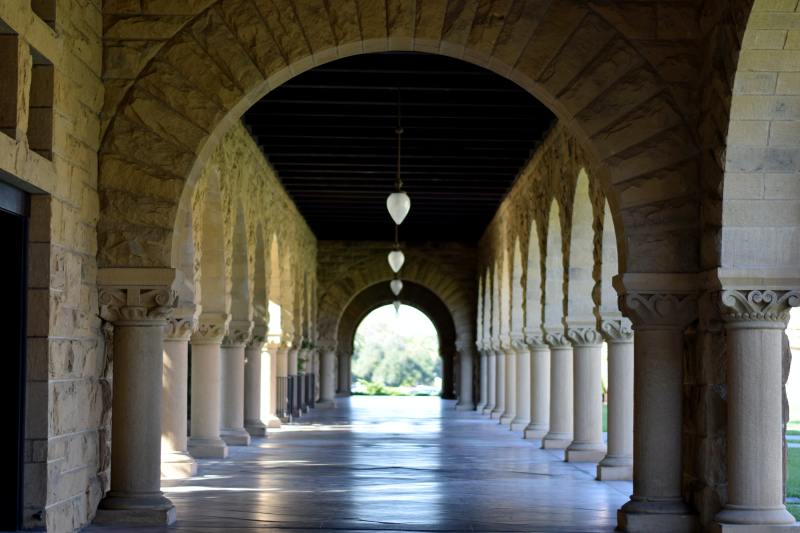Amid concern surrounding sexual violence on campus and student safety, the University has moved forward with a multi-million-dollar plan to expand the campus video security system. But that expansion has been met with concern from some students and faculty that the surveillance could undermine student safety and disproportionately target students of color.
The details of the expansion were made public in April when Stanford announced it would expand the campus’s video security system to several residential buildings and a parking garage beginning in summer 2022. Then, at a Faculty Senate meeting on Oct. 20., Patrick Dunkley, the vice provost for institutional equity, access and community, specified the budget for the expansion: $2.5 million.
The University plans to install a total of 250 cameras per year over the next four years, according to University spokesperson Luisa Rapport.
“The cameras could be used to investigate both violent and non-violent crimes, such as burglaries,” Rapport wrote.
But the status of the expansion remains unclear. Spokespeople for the University and the Stanford University Department of Public Safety (SUDPS) were tight-lipped when pressed for specifics by The Daily.
The University declined to comment on the history of cameras on campus, the changes in the standards and regulations of the video security system on campus and the University’s stance on the deployment of security cameras on campus. The spokesperson referred The Daily to the April press release and the Video Safety and Security Systems’ (VSSS) website.
Bill Larson, the SUDPS spokesperson, declined to comment on the location of currently active security cameras, where the University plans to add cameras, and the role that cameras play, if any, in SUDPS’ response to reported crimes. Larson referred The Daily to the same April press release.
Four months after the University’s April announcement in August, a woman reported to a mandatory reporter that she had been raped at an unspecified parking lot near Wilbur Hall, according to a message sent out through AlertSU.
The Wilbur Field Garage was one of the locations identified by the University in April as a target for camera expansion.
University officials and spokespeople declined to say whether cameras had yet been placed in the area. When asked a similar question about cameras in the Wilbur Field Garage, Matthew Ricks, senior director of IT facilities infrastructure, referred The Daily to the University’s spokespeople.
Two months after the August incident, another woman reported to a mandatory reporter that she had been raped in the basement of a University building, according to AlertSU. The alert then ignited an outcry of concern among students about public safety and protests against sexual violence on campus — and a revival of the campus debate surrounding the cameras.
Students and faculty expressed concern about the implementation of security cameras and who will have access to the footage.
“I am concerned however about a surveillance system in that … once in place, [it] can be used for anything,” wrote comparative literature professor David Palumbo-Liu in an email to The Daily. “That raises issues of privacy that we need to address. We cannot let the technology run ahead of a serious discussion about its implementation, proper use and possible abuse.”
Palumbo-Liu added, “It has been proven that [cameras] are a deterrent and that they aid in identifying assaults and offenders, so that is good. But, as one ASSU representative asked at Faculty Senate — what about how we punish perpetrators of sexual violence and harassment — shouldn’t we be equally aggressive about that?”
Computer science and electrical engineering professor Philip Levis added that he is concerned about the risks posed by the sharing of video surveillance footage with law enforcement.
According to the University’s VSSS Standards website, SUDPS and “designated local managers” can access footage from the surveillance cameras, but any “export of footage” will be first approved by the Office of General Counsel or by SUDPS directly with a case number.
However, Levis said the policy outlined by the VSSS is “vague” and “not very concrete” about when footage will be shared.
“The point being that once these recordings exist, they might not be used only by Stanford,” Levis said. “Stanford might be put into a position in which it is forced to participate [in] actions or policies which it doesn’t agree with.”
Levis said a balance can be found between implementing video surveillance on campus and addressing community privacy concerns.
“I’m a professor of engineering, right; I believe in quantitative mechanisms. You can deploy cameras to help people feel safer and there is some value to that,” Levis said, warning that the installations could cause crime to instead move elsewhere instead of preventing it. “I think there’s much greater value in actually making people safer.”
Paco Poler ’23 M.A. ’24 , a senior and coterm student who is a member of Abolish Stanford and the Stanford Decarceration collective, expressed disappointment and skepticism about Stanford’s security initiatives.
Poler stressed the importance of acknowledging that conversations surrounding campus safety are not new, despite reinvigorated momentum on the issue.
“Security measures of all sorts, including the ones they intend to implement, are used to target the most vulnerable students on this campus, BIPOC people predominantly,” Poler said. “They are not making anyone safer because we know that the risks that exist on this campus happen predominantly with people you know, in contexts that are not going to be recorded anyway.”
“The threats that are posed to vulnerable students on this campus are very real and people in Abolish Stanford want to organize against that,” Poler added. “We hope that if students continue to tell the University, tell the community, [we’ll] make it known that this is not what we want, this does not make us feel safer. Maybe if we yell long enough the University will listen to us.”
Correction: An earlier version of this article misstated the number of cameras that will be added to campus. The Daily regrets this error.
